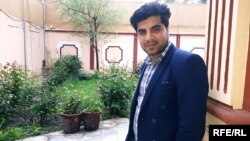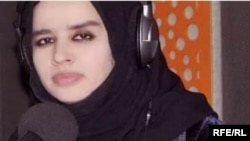If there were any doubt, the danger faced by journalists in carrying out their work in Afghanistan was made tragically clear on April 30, when a total of 10 reporters were killed in separate attacks.
Among the killed were three RFE/RL colleagues -- two reporters and a trainee who was about to start work. On May 3, which is marked around the globe as World Press Freedom Day, RFE/RL remembered the sacrifices that its journalists and others have made in pursuit of press freedom.
"Sometimes journalists die by accident, caught in crossfires or other sudden circumstances," RFE/RL President Tom Kent said at a memorial service held at RFE/RL's headquarters in Prague. "This was different. This was murder, premeditated murder directed specifically against journalists."
Video producer Sabawoon Kakar, 30; video journalist Abadullah Hananzai, 26; and university student and trainee Maharram Durrani, 28, were among nine journalists killed in a suicide bombing in Kabul on April 30.
Kakar and Hananzai were covering an earlier suicide attack when a second bomber, disguised as a reporter, approached the throng and detonated his explosives. Durrani was also on the scene and was killed in the attack.
Claimed by Islamic State (IS) militants, the two blasts combined killed at least 25 and injured 45. Later the same day a BBC journalist was shot and killed in the eastern province of Khost.
Hashem Mohmand, director of RFE/RL's Radio Free Afghanistan, described Kakar, Hananzai, and Durrani as "promising young journalists who had the potential of becoming future role models. Their cruel murders remind us daily that our contribution to peace and stability is vital."
'Brave Young Journalists'
Kakar was a key member of Radio Free Afghanistan's video team who was just a day short of completing his fifth year with RFE/RL. His work included feature stories about social issues in Afghanistan as well as news about counterterrorism operations and security issues.
"Sabawoon Kakar, our brave young journalist, was always rushing to cover suicide attacks and bomb blasts to get people the most accurate information from the ground," said Qadir Habib, a senior editor for Radio Free Afghanistan.
Hananzai was a video journalist who had been working since October 2016 on an antinarcotics project called Caravan Of Poison. A graduate of Kabul University, Hananzai was preparing to celebrate his first wedding anniversary on May 8.
Habib recalled a trip to Kabul last year during which he spoke to Hananzai about the dangers he faced in reporting on the drug trade. "I told him: 'It's a very challenging project you will be working on. There are dangerous people involved.' But he just smiled at me and said, 'It doesn't matter how difficult it is because we are not afraid of covering difficult stories. What matters is that we reveal the truth.'"
"I was really amazed by the bravery and courage of these two young men," Habib added.
Durrani was being trained to take part in a weekly woman's program at Radio Free Afghanistan -- a job she was due to start on May 15.
She was a third-year student of Islamic law at Kabul University who was just starting her career as a journalist. "She was confident and passionate about reporting on women's issues in Afghanistan," said Mohmand, who met Durrani last month in Kabul.
Media Gains Under Threat
The Taliban and the IS militant group have threatened and deliberately targeted major TV and radio stations and their staff members recently across Afghanistan, carrying out deadly attacks that have killed dozens of journalists and media employees.
The attacks have made Afghanistan one of the deadliest countries in the world for journalists.
"Afghanistan's journalists are among the bravest in the world. Working in some of the most difficult conditions, they have faced threats, intimidation and violence for simply doing their jobs," said Omar Waraich, Amnesty International's deputy director for South Asia, in a statement to mark World Press Freedom Day.
"At a time when many have sadly turned their attentions away from the country, and the work of a journalist means constantly putting your life at risk, they have continued to confront injustice and give voice to victims,"
Twenty journalists and media workers were killed in Afghanistan in 2017, marking the deadliest year for reporters in the country, according to the Afghan Journalists Safety Committee, a local media watchdog.
The International Federation of Journalists and its affiliate, the Afghan Independent Journalists Association, said at least 73 journalists and media workers were killed in Afghanistan from 1994 to 2017.
Afghanistan's media development is often cited as one of the biggest achievements of the past decade, following years of Taliban strictures or outright prohibitions on all forms of music and television, as well as independently reported news.
Despite the gains, independent media have come under constant attack and pressure not only from militants but also from religious leaders, ex-warlords, and sometimes even the government itself.
Media watchdog Reporters Without Borders ranked Afghanistan 118 out of the 180 countries in its Press Freedom Index.
International media watchdogs say militants have greatly contributed to the climate of fear by explicitly targeting journalists for reporting deemed unfavorable and have condemned the impunity enjoyed by those responsible for crimes of violence against media personnel in Afghanistan.










